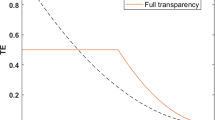Abstract
We study how a contest organizer who seeks to maximize participant effort should disclose the information on the actual number of contestants in an imperfectly discriminatory contest with stochastic entry. When each potential contestant has a fixed probability of entering the contest, the optimal disclosure policy depends crucially on the properties of the characteristic function H(⋅)=f(⋅)/f ′(⋅), where f(⋅) is the impact function. The contest organizer prefers full disclosure (full concealment) if H(⋅) is strictly concave (strictly convex). However, the expected equilibrium effort is independent of the prevailing information disclosure policy if a linear H(⋅) (Tullock Contest) applies.
Similar content being viewed by others
References
Baye, M. R., Kovenock, D., & de Vries, C. G. (1994). The solution to the Tullock rent-seeking game when R>2: mixed-strategy equilibria and mean dissipation rates. Public Choice, 81, 362–380.
Fu, Q., & Lu, J. (2008). A micro foundation of generalized multi-prize contests: a noisy ranking perspective (Working paper).
Fudenberg, D., & Levin, D. (1989). Reputation and equilibrium selection in games with a patient player. Econometrica, 57, 759–778.
Fudenberg, D., Kreps, D., & Maskin, E. (1990). Repeated games with long-run and short-run players. Review of Economic Studies, 57, 555–573.
Higgins, R. S., Shughart, W. F. II, & Tollison, R. D. (1985). Free entry and efficient rent seeking. Public Choice, 46, 247–258. Reprinted in R.D. Congleton, A.L. Hillman, & K.A. Konrad (Eds.), 2008, 40 years of research on rent seeking 1: theory of rent seeking (pp. 121–132). Berlin: Springer.
Kreps, D. (1990). A course in microeconomic theory. Princeton: Princeton University Press.
Lim, W., & Matros, A. (2010). Contests with a stochastic number of players. Games and Economic Behavior, 67, 584–597.
Münster, J. (2006). Contests with an unknown number of contestants. Public Choice, 129(3–4), 353–368.
Myerson, R. B. (1981). Optimal auction design. Mathematics of Operation Research, 6, 58–73.
Myerson, R. B., & Wärneryd, K. (2006). Population uncertainty in contests. Economic Theory, 27, 469–474.
Shapiro, C. (1982). Consumer information, product quality, and seller reputation. Bell Journal of Economics, 13, 20–35.
Shapiro, C. (1983). Premium for high quality products as returns to reputations. Quarterly Journal of Economics, 98, 659–679.
Skaperdas, S. (1996). Contest success function. Economic Theory, 7, 283–290.
Tullock, G. (1980). Efficient rent seeking. In J. Buchanan, R. Tollison, & G. Tullock (Eds.), Towards a theory of the rent-seeking society (pp. 97–112). College Station: Texas A&M University Press.
Wärneryd, K. (2001). Replicating contests. Economics Letters, 71, 323–327.
Author information
Authors and Affiliations
Corresponding author
Rights and permissions
About this article
Cite this article
Fu, Q., Jiao, Q. & Lu, J. On disclosure policy in contests with stochastic entry. Public Choice 148, 419–434 (2011). https://doi.org/10.1007/s11127-010-9662-1
Received:
Accepted:
Published:
Issue Date:
DOI: https://doi.org/10.1007/s11127-010-9662-1



